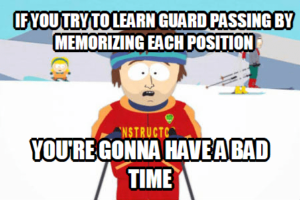Guard passing is a big part of BJJ, but often times new students prefer to develop guards first.
As a big fan of passing, I wondered why so many avoided it. When speaking to white belts and thinking back on my own experience I began to notice some trends. One question kept coming up. Does the way we use positions in BJJ to explain techniques make certain things harder to learn? Lets walk through positions and how thinking about guard passing differently might help you progress faster.
I Don’t Know Where My Hands Go
The first thing we learn when beginning BJJ are the basic positions. We were all plopped down into side control or mount and walked through where to put our hands and feet. Over time, these positions become pools of knowledge. A student knows a pile of techniques from each position and uses that point of reference to ask questions of the instructor.
Effectiveness then becomes a game of keeping the positions you know for as long as possible. The longer your keep that spot the more you can use your arsenal to win. This development leads to common comments from students like: “I’m fine once I get to my spot!” From here, students build a bunch comfortable positions and the links between them increase. Treating BJJ like a map of “if” and “then” questions is a great way to map out your game for competition.
Positions are also valuable because they represent a known. The brain assesses the current situation with familiar checklist of attributes. For example, in an opponent’s closed guard, how do you assess your situation? Is your back straight? Are you in control of the grips? Are you on the balls of your feet? As you get more experienced this process becomes near instantaneous.
Where Does Passing Start and Stop?
The one major aspect of BJJ that can conflict with this style of learning is guard passing. Passing the guard is both an activity and a goal rather than a position. Most instructors use static positions such as the over-under or bullfight to explain passing. Students can then build the same pools of knowledge they leverage in more dominant spots. Over time, some students over-emphasize starting a pass, but not finishing one. Symptoms of this come out in drilling. Guard passing become a blur in the second half as the student executes their pass and leaps right to a dominant position. It’s almost like there’s a mental leap from the new move to the comfortable spot. Things then fall apart during sparring as their opponent fights to recompose guard throughout. The move never gets to that final perfect spot and can cause confusion.
So what happens when that same student wants to fix their pass?
Since positions are the reference point for questions, students often ask about the dominant spot at the end. The issue becomes about “keeping” that comfortable position . Passing becomes binary. Either you’ve passed and you’re fighting to keep your position or not and you should try again. The problem is that passing can not stay binary. To the more advanced player, guard passing is a fluid process and entire matches are won and lost in the space between passed and not. There are lots of near pass transitions that need to be countered such as granby rolls and turtling. How should you deal with so much complexity?
Drill Every Pass Position?
So what is a new student to do? From past experience, the knee jerk reaction might be to break things into further positions. This is where things go off the rails. Too many positions means that each one gets less work and slows progress. More positions also means more pause moments where your brain has to reassess your situation and adjust. Pauses slow things down and make your game more vulnerable to counters. The solution instead is to merge guard passing into one concept with one goal.
What is a Guard Pass?
Sit down tomorrow and ask a training partner what it means to pass the guard. Its amazing the different answers you hear. It should be simple right? You were in someone’s guard and now you’re not. Boom, guard passed! IBJJF rules say passing the guard is “surmounting” the legs of the opponent on bottom and holding a position for three seconds. Once again, it’s a binary concept. We should all just go back and practice our “surmounting?” (IBJJF Rules)
Why Pass the Guard?
The first day of class I remember trying to shoulder-lock my opponent from inside his closed guard. A tough but patient purple belt who always wore socks, he spun like a top and arm-barred me. I found that choking from inside the guard was equally perilous. One second I’d be trying to choke my opponent, and the next he’d have me stuck in mount. Why pass the guard? Because you respect it. A good guard player can catch their opponent in never-ending loops of attacks. Why would you stick around for that? Passing enables the top player to apply efficient leverage with their attacks.
So we pass the guard to apply leverage and know we’ve passed the guard when the opponent can’t use their legs against us. What about during the pass? For new students, the emphasis is too heavy on getting through, under, or past the guard. Why not weaken it instead?
Weaken the Guard, Then Pass it!
Next time you’re rolling with an opponent. Change the concept of passing to “weakening” the guard. Instead of treating your opponent’s guard as an after-thought, make it a priority. A great example of this is the double-under pass. Early users of this technique often emphasize getting passed the leg often by throwing the opponent’s leg to one side. This extra momentum allows advanced BJJ players to get their guard back. As you drill the movement, use the concept of weakening the legs to guide your motions. Compress and control the hip while maintaining good forward pressure. Restrict their space while keeping your opponent bent at the waist. Weakening the guard rather than passing will also help you to transition between passes. When stuck inside a strong half guard, an easy way to weaken rather than pass is pick up the knees and push them the other direction. Weaken the legs and the pass will come.
This concept may sound simple but it will keep you focused during your roll, and rob your opponent of opportunities. Try it out and see what you think!


